WARNING : IMAGES OF MEDICAL PROCEDURES MAY CAUSE DISTRESS
Many pet birds are commonly sold with a band on one of their legs. Banding or ringing used to be the traditional way of identifying pet birds. Leg bands are often applied by the breeder to help identify and keep track of their birds. Band numbers are used to identify and keep records on breeding birds. For example leg ring numbers are used to pair unrelated birds in order to keep the gene pool diverse and breed for certain traits and mutations.
Breeders usually apply closed leg rings on young chicks when their small feet will fit through the hole. As the birds grow the leg bands cannot be removed unless cut off. Open bands may be put on mature birds after surgical or DNA sex determination. Sexing bands are put on the right leg to indicate males and the left leg to indicate females. Some pet bird owners have leg rings applied to their pets with identifying information of phone numbers and address engraved on the surface of the band. Leg rings can be manufactured from stainless steel or aluminium.
All leg rings on pet birds require periodic checking to make sure that there are no problems or discomfort relating to the fit of the band or the ring. As an avian veterinarian, I am often presented with birds suffering great pain and discomfort from ill-fitting, tight or misshapen bands that have acted as a tourniquet on their legs.
Budgies and canaries commonly suffer from scaly mites that burrow into the bare skin of the legs and feet and cause a thickening and flaking of the skin in these areas. As a result the leg bands become tight and “ring-bark” the legs.
Often owners have not noticed any problem as the feathers tend to hide the legs.
Birds with larger beaks, such as sun conures and Indian Ringnecks can bite at aluminium, open bands and squash them out of shape. This action can also cause the ring to act as a tourniquet and cause swelling and constriction of the leg.
Just recently I had to operate on a sun conure to remove a constricting leg ring that was encased in skin and tissue. The bird’s skin had actually grown over the problem band. Leg rings can also get caught in cages and toys which can lead to breaks, cuts, dislocations and sprains. If seeds or twigs get caught under a leg ring, subsequent irritation can cause swelling and constriction of the foot and leg. In the worst case scenario, amputation of the affected foot is necessary.
Because of all of the injuries and problems that I’ve treated as a result of constricting leg rings, I usually recommend the removal of leg bands from pet birds. Removal of most bands is a simple procedure and will prevent any potential injuries occurring. Owners should never attempt to remove a leg ring themselves. Always consult your avian veterinarian, who will safely remove the band and prevent injury to the bird.
Microchips are a much safer and more convenient way of identifying your pet bird. Microchips are about the size of a grain of rice and can be quickly and safely implanted into the breast muscle of the bird. Each microchip contains a unique number which is recorded and registered to the owner through a microchip company. It is common practice for veterinarians and animal shelter workers to scan any lost birds for microchip identification which link the lost bird directly to their owner.
If anyone finds a stray or lost bird, they should always take them into their local veterinarian and have them scanned, in case the bird has a microchip. The microchip is the safest way to identify your pet bird and to ensure that it is returned to you in case it gets lost.
© Peter Wilson July 2010
FAQs
There are a few risks associated with using leg bands on birds. If the band is too tight, it could cut off circulation and cause tissue damage. If the band is not applied correctly, it could rub on the bird’s skin and cause irritation, or worse, impede the bird’s natural movement, which can lead to joint problems and deformities. Leg bands can also fall off, which could be dangerous if the bird swallows it.
Closed leg rings are usually placed on young chicks by breeders when their feet are still small enough to fit through the hole. Once the bird has grown however, the leg band cannot be removed unless it is cut off. If the leg band on your bird has become too tight, you should do an online search for an exotic bird vet near me and take your bird there immediately so that they can safely remove the band. Never try to remove the band yourself as you may cause serious injury to your bird.
You should never try to remove the leg ring by yourself as you may injure your bird. You should search online for avian doctors near me and take them to one so that they can safely remove the band without causing injury to your feathered friend. At Currumbin Valley Vet we generally recommend removing leg bands early on from pet birds due to the risk of injuries and problems caused by constricting leg rings.
Leg bands are placed on birds by breeders and there is no database that records these leg bands, so it is not easy to identify where they came from. However the bird may be microchipped so you should search for an exotic pet vet near me and take the bird to them – they will be able to scan the bird to find the microchip number. This number is linked to a secure database registry containing the contact details of the bird’s owner.

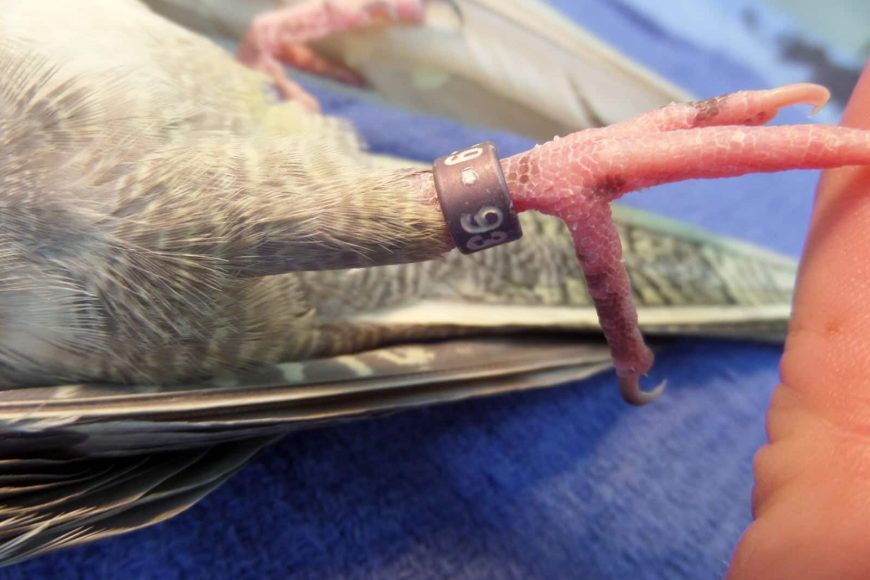
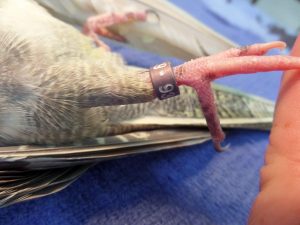

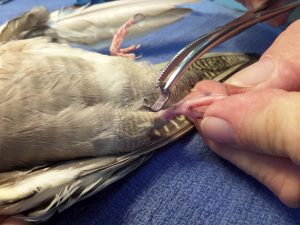
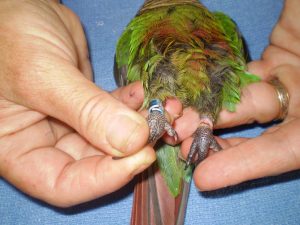
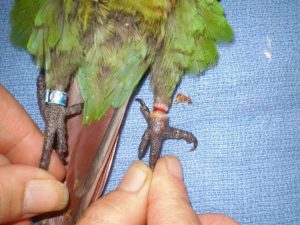
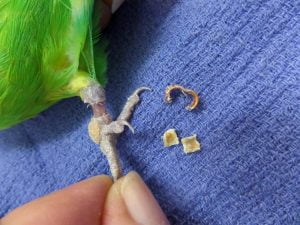
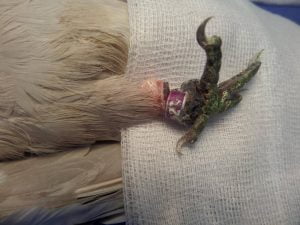
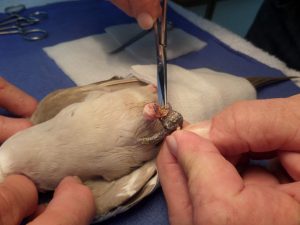
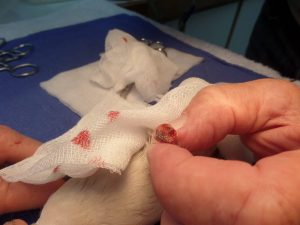
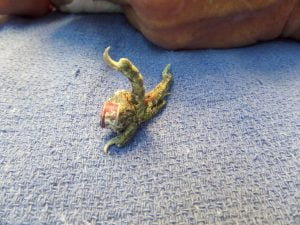
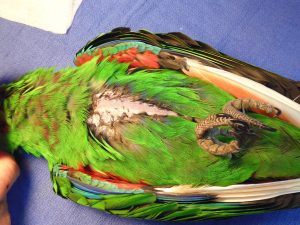
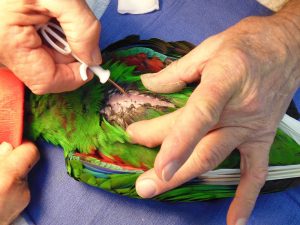



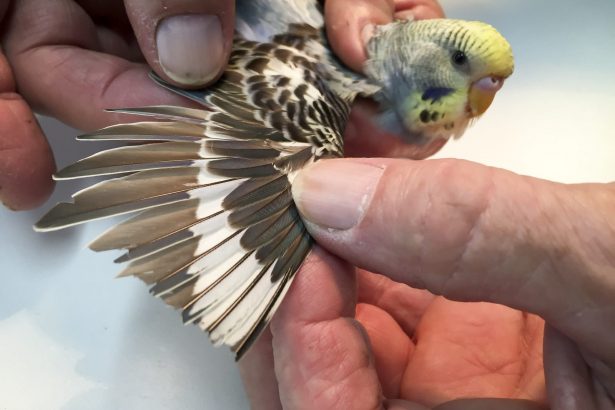

I rescued a green check conure. I cannot find out what it’s leg band means. Nothing I find is even close! Looking for help the band number is 70B MN 613. The mn I assume is Minnesota. It is actually printed sideways. Any clue on the origin of my bird?
Leg rings are placed on birds by breeders – they help birds from different groups as an aid to prevent inbreeding – we suggest you take the bird into your local veterinary surgery and have it scanned to see if it is microchipped.
Hello a bird was given to me a while ago it has a band how can I find owner
Leg bands are put on birds by breeders – they help breeders identify one set of birds from another to prevent inbreeding – they do not identify the birds.
Hi
I have found a lost Quaker parrot with a breeders leg ring. It is extremely friendly and obviously someone’s loved pet. I am trying to locate the breeder so I can find the owner. Is there a database with the breeders ring numbers?
Thank you
There is not data base with leg ring information. Nowadays, birds are microchipped – take the bird into a veterinary surgery and have it scanned for a microchip number
I am trying to find out info on a leg band that is on a military macaw.
Silver,its completely round(not a flat round)
LAGS 006
Any info would be greatly appreciated.
Thankyou
Leg rings are placed on birds by breeders – there is no central data base recording leg ring numbers
Hello I found a Bird with a bird band and want to know the owners as this bird is so beautiful and much loved. How can I find the owner?
Leg rings are placed on birds by breeders – they help birds from different groups as an aid to prevent in breeding – take the bird into your local veterinary surgery and have it scanned to see if it is microchipped
I have a yellow Indian Ringneck which has a leg band on it with the number 1125, just not sure what it means. Could you please clearly explain what it is and what it stands for????
Leg rings are placed on birds by breeders – they help identify one set of birds from another as an aid to prevent in breeding
My cockatoos tag is seeming to rub under neath her foot and going pink, the foot band is still fairly loose but she’s only a year old, I noticed last week it was gradually getting worse, I just wanted to know if I should take it off or replace it because it does look like it’s starting to corrode or rust and I’m afraid she might be uncomfortable with it on but I would like her to have one, but not if it hurts her at this point in time
Do you stock plastic rings that can be clipped on to the legs of my pet fantail pigeons? I am interested in them
for my pet pigeons. Thank You.